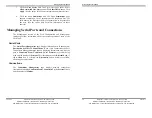
Introduction
Chapter 1
Manual Documentation Number: LWS300A-1105m
3
Black Box Corporation - 1000 Park Drive - Lawrence, PA 15055-1018
www.blackbox.com
-- Tech Support and Ordering: 724-746-5500 - Fax: 724-746-0746
Virtual COM Port
Virtual COM Port
mode (also called COM port redirection)
allows you to
map a COM port on your PC to the serial port on your LWS300A. Using the
RealPort software
(included with the LWS300A) you create virtual COM
ports on your PC. When your application sends data to this port, RealPort
redirects the data across the network to serial device connected to the
LWS300A serial port. The network is transparent to the user application and
the serial device connected to the LWS300A.
Paired Mode
Paired Mode
(also called
Serial Tunneling
or
Serial Bridge
mode)
allows
serial devices connected to two LWS300A serial servers to communicate
across a network. The two LWS300A serial servers automatically connect to
each other.
In Paired Mode the
heartbeat feature
ensures reliable communications by
restoring the connection if communications are temporarily lost at either end
due to loss of power or Ethernet connection.
Other Communications Modes
LWS300A Wireless Serial Servers also feature the following
communications profiles:
Terminal Mode
allows you to connect a PC running terminal software to the
LWS300A serial port and communicate with the LWS300A via a command
line interface.
Modem Emulation Mode
allows you to configure the serial port to operate
as if it is a modem. For legacy applications where a serial device is set up to
communicate through a modem, the serial device can now be connected to
the LWS300A and communication occurs over the network. The LWS300A
emulates modem responses to and from the serial device.
In
Console Management Mode
the LWS300A can be configured for
connection to the management port typically found on network devices such
as routers, switches and servers. This allows remote management of the
network device. Communication can be accomplished using telnet to a
specific port in the serial server.
Custom Mode
allows you to custom configure the LWS300A serial port and
is used if your application does not fit into any other predefined modes.
Introduction
4
Manual Documentation Number: LWS300A-1105m pn7008-rev000
Chapter 1
Black Box Corporation - 1000 Park Drive - Lawrence, PA 15055-1018
www.blackbox.com
-- Tech Support and Ordering: 724-746-5500 - Fax: 724-746-0746
802.11 Wireless Networking Basics
LWS300A wireless serial servers
allow you to connect non-network-
enabled serial devices into a wireless network, giving you the capability to
gather more data and implement remote programming and management.
Serial devices no longer are limited to a physical connection to a PC. The
serial device can be connected to an LWS300A wireless serial server
anywhere within range of an 802.11b-compatible wireless access point.
Communication occurs transparently using TCP/IP or UDP/IP over a
wireless link. This allows traditional Windows PC software access to serial
devices anywhere on the wireless network.
The enabling technology for LWS300A wireless serial servers is based on
the IEEE 802 standard. Some background on the standard follows.
802.11 Wireless Networking
IEEE 802.11
is a set of standards that defines how multiple devices can
communicate on a wireless network. The standard has grown into a set of
several standards that define various features and functions. The 802.11b
standard defines the physical and data link layers for a wireless network
using the 2.4 GHz frequency band, a band that does not require licensing. As
a part of the IEEE family of standards, 802.11 WLANs are easily connected
to 802.3 (Ethernet) LANs. Higher layer LAN protocols, network operating
systems and internetworking protocols such as TCP/IP integrate seamlessly.
Under the IEEE 802.11 standard there can be two different types of devices
on the wireless network:
stations
and
access points (AP)
. A
station
may be a
PC equipped with a wireless network adapter or it can be a wireless serial
server such as the LWS300A. An 802.11
access point
is a radio with an
interface that allows connection to a wired LAN. Access points run bridging
software to facilitate the connection from wireless to wired network. The
access point becomes the base station for the WLAN. It aggregates access to
the wired network for multiple wireless stations. An access point may be a
standalone device, such as a wireless router or switch, or a card in a PC.
Wireless Network Configurations
The 802.11 standard defines two modes of operation:
infrastructure mode
and
ad hoc mode
.
Infrastructure mode
makes use of one or more access
points connected to a wired LAN. Wireless stations communicate with access
points to gain access to each other and/or the LAN. In the Basic Service Set




















